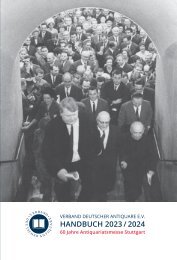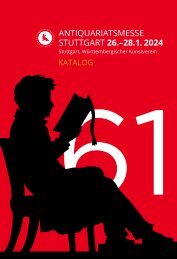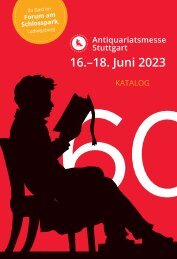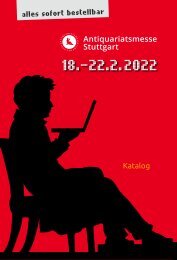Antiquariatsmesse Stuttgart 2021 - Katalog
Katalog zur Antiquariatsmesse Stuttgart 2021: Die Antiquariatsmesse Stuttgart als größtes Schaufenster für wertvolle Objekte des Antiquariats- und Graphikhandels in Deutschland findet in diesem Jahr in ungewohnter Form statt. Da eine Präsenzmesse nicht stattfinden kann, haben sich 76 Kollegen aus Deutschland, Großbritannien, Österreich, Frankreich, der Schweiz, den Niederlanden, den Vereinigten Staaten und aus Australien zusammengefunden, um einen Katalog für die Messe zu erstellen und gleichzeitig ein Angebot für eine virtuelle Messe zusammengetragen. Der Katalog wird am 7. Januar 2021 an interessierte Kunden verschickt, die virtuelle Messe öffnet ihre „digitalen Pforten“ am 29. Januar 2021 um 12.00 Uhr unter www.antiquariatsmesse-stuttgart.de
Katalog zur Antiquariatsmesse Stuttgart 2021: Die Antiquariatsmesse Stuttgart als größtes Schaufenster für wertvolle Objekte des Antiquariats- und Graphikhandels in Deutschland findet in diesem Jahr in ungewohnter Form statt. Da eine Präsenzmesse nicht stattfinden kann, haben sich 76 Kollegen aus Deutschland, Großbritannien, Österreich, Frankreich, der Schweiz, den Niederlanden, den Vereinigten Staaten und aus Australien zusammengefunden, um einen Katalog für die Messe zu erstellen und gleichzeitig ein Angebot für eine virtuelle Messe zusammengetragen.
Der Katalog wird am 7. Januar 2021 an interessierte Kunden verschickt, die virtuelle Messe öffnet ihre „digitalen Pforten“ am 29. Januar 2021 um 12.00 Uhr unter www.antiquariatsmesse-stuttgart.de
Sie wollen auch ein ePaper? Erhöhen Sie die Reichweite Ihrer Titel.
YUMPU macht aus Druck-PDFs automatisch weboptimierte ePaper, die Google liebt.
Hellmut Schumann
Holzgasse 4 · 8001 Zürich, Schweiz
Telefon +41 (44) 251 02 72 · Fax +41 (44) 252 79 61
E-Mail: info@schumann.ch · Internet: www.schumann.ch
Alte Drucke · Inkunabeln · Helvetica · Geschichte der Wissenschaften · Illustrierte Bücher
Ages to Saint Augustine. The book has the form of an
“inner dialogue” in which questions are posed, discussions
take place and answers are provided, leading to
self-knowledge. The 4-page text at the end by Jacobus
Mediolanensis (fl. 13th c.) describes the “ten grades by
which man can reach perfection” and is a summary of
his “Stimulus amoris” (the goad or prick of love), one of
the most important Franciscan tracts of that time, frequently
attributed to Saint Bonaventura. – A final bifolium
containing the table may have been issued in a few
copies only. First leaf with small hole and light soiling,
occasional minor mostly marginal soiling, otherwise a
fine copy. – HCR 2018*; GW 3017 (Pseudo-Augustinus,
44ff., also without the table: „Einige Ex. mit einer
2 Bl. umfassenden Tabula am Schluss“); BMC VI, 681;
Goff A-1329; IGI 1047; CIBN A-761; Proctor 6351;
Pell 1523; Walsh 2995; Bibl. Apost. Vaticana IV.119(3);
Pollard, Italian Book Illustrations (1894), p. 57; Kristeller,
Early Florentine Woodcuts 10a, pl. 20; Hind II,
547. fig. 306; Sander 692 (woodcut); Geldner, Inkunabeldrucker
II, p. 100f. – See illustration.
Augustinus, Aurelius (Pseudo-). Soliloquii di
Sancto Augustino Vulgari (Italian). And: Jacobus
Mediolanensis. (Stimulus amoris, cap. I) Dieci gradi
per equali viene lhuomo a perfectione (Italian). With
a nearly full-page woodcut of St. Augustinus on the
title, 1 large woodcut initial. Printed Lombard initials.
Roman type. 28 lines. 44 unn. leaves. Sm. 4to
(205 × 140 mm). Brown morocco with gold-lettered
title on spine, richly gilt. In a slipcase. Florence,
(Laurentius de Morgianis and Johann Petri of
Mainz), 10 November 1491. € 18 500,–
First illustrated edition in Italian of a very rare Florentine
incunabulum. No copy found in a German library.
The only European copies outside Italy are kept in the
holdings of the BL London (1 copy) and in the BN
Paris (2 copies). The BN copies have no table like this
present one, and their 2nd copy otherwise is imperfect.
The large title-woodcut shows Saint Augustine writing
in his study, surrounded by his accoutrements, his mitre
and staff. The illustration is an exceptional example of
the outline style of woodcuts of Florentine imprints
in the 1490s. This treatise was attributed in the Middle
Erasmus, Desiderius. In novum testamentum Annotationes,
ab ipso autore iam quartum recognitae
… auctario neuti[quam] poenitendo locupletatae.
Half-title with woodcut printer’s device, title-page
within woodcut architectural border, 2nd title-page
fol. 1v. with different figured woodcut border,
different printer’s device on last leaf verso and at
the end, numerous large and small figured woodcut
initials in the text, by Urs Graf, Ambrosius Holbein,
and Hans Frank. 4 leaves, 710, (1) pp.; (28) leaves
index. Folio. 17th century calf, back gilt (joints and
foot of spine somewhat restored). Old ms. name on
title. Basel, Joh. Froben, Febr. 1527. € 8200,–
An important document of the humanistic spirit. Remarkably
beautifully printed during Erasmus`lifetime
with outstanding book decoration. In the early years
of the 16th century the demand for the original text
of the New Testament began to mount and Erasmus
(1467–1536) soon saw the necessity to translate the
original Greek text into Latin. His first text-critical
edition of the New Testament was one of the important
foundations for Reformation theology. These present
commentaries by Erasmus were the first ferment of
theological discussion at that time and are of great
value. This is the 4th printing of the additional text
notes contributed by Erasmus. They show mistakes
that ancient theologians had made during their translation,
and revealed misunderstandings that had arisen
244






